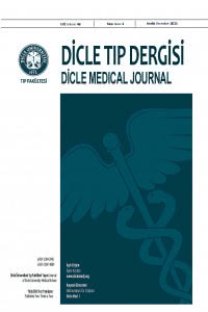The Relationship Between IgA Vasculitis and Antioxidant Activity In Children
Çocuklarda IgA Vasküliti ile Antioksidan Aktivite Arasındaki İlişki
___
1.Jennette JC, Falk RJ, Bacon PA, et al. 2012 RevisedInternational Chapel Hill Consensus ConferenceNomenclature of Vasculitides. Arthritis Rheum.2013; 65: 1-11.2.Piram M, Mahr A. Epidemiology ofimmunoglobulin A vasculitis (Henoch-Schönlein):current state of knowledge. Curr Opin Rheumatol.2013 ;25: 171-8.
3.Rigante D, Castellazzi L, Bosco A, et al. Is there acrossroad between infections, genetics, and Henoch-Schönlein purpura?. Autoimmun Rev. 2013; 12:1016-21.
4.Kattoor AJ, Pothineni NVK, Palagiri D, et al.Oxidative Stress in Atherosclerosis. CurrAtheroscler Rep. 2017; 19: 42.
5.Dalbaşı E, Gedı̇k E, Tüzün A, Obay B. Correlation ofMalondialdehyde and Antioxidant Enzyme Levelswith Peritonitis Severity in Patients withGeneralized Peritonitis. Dicle Med Journal. 2020; 47:293-03.
6.Lü JM, Lin PH, Yao Q, Chen C. Chemical andmolecular mechanisms of antioxidants:experimental approaches and model systems. J CellMol Med. 2010; 14: 840-60.
7.Narayanankutty A, Job JT, Narayanankutty V.Glutathione, an Antioxidant Tripeptide: Dual Rolesin Carcinogenesis and Chemoprevention. CurrProtein Pept Sci. 2019; 20: 907-17.
8.Engin KN. Alpha-tocopherol: looking beyond anantioxidant. Mol Vis. 2009; 15: 855-60.
9.Berger MM, Oudemans-van Straaten HM. VitaminC supplementation in the critically ill patient. CurrOpin Clin Nutr Metab Care. 2015; 18: 193-201.
10.Sies H, Stahl W. Vitamins E and C, beta-carotene,and other carotenoids as antioxidants. Am J ClinNutr. 1995; 62: 1315-21.
11.P. Padmanabhan, A. Cheema, G. Paliyath,Solanaceous Fruits Including Tomato, Eggplant, andPeppers. Encyclopedia of Food and Health, 1st edn.Oxford: Academic Press, 2016; 24-32.
12.Vance TM, Su J, Fontham ET, et al. Dietaryantioxidants and prostate cancer: a review. NutrCancer. 2013; 65: 793-801.
13.Túri S, Németh I, Torkos A, et al. Oxidative stressand antioxidant defense mechanism in glomerulardiseases. Free Radic Biol Med. 1997; 22: 161-68.
14.Demircin G, Oner A, Unver Y, et al. Erythrocytesuperoxide dismutase activity and plasmamalondialdehyde levels in children with HenochSchönlein purpura. Acta Paediatr. 1998; 87: 848-52.
15.Mills JA, Michel BA, Bloch DA, et al. The AmericanCollege of Rheumatology 1990 criteria for theclassification of Henoch-Schönlein purpura.Arthritis Rheum. 1990; 33: 1114-121.
16.Cassidy JT, Petty RE: Textbook of PediatricRheumatology: Leucocytoclastic vasculitis, 5th edn.Philadelphia, Elsevier Saunders, 2005; 496–512.
17.Ece A, Yolbaş İ, Balık H, et al. Henoch-Schönleinpurpura in childhood: Review of 214 patients, J ClinExp Invest. 2012; 3: 91-5.
18.Akça Ü, Akça G, Nalcacıoğlu H, et al. Evaluation ofepidemiological, clinical and laboratory findings inHenoch Schönlein purpura. Turkish Journal ofFamily Practice. 2020; 24: 87-94.
19.Peru H, Soylemezoglu O, Bakkaloglu SA, et al.Henoch Schonlein purpura in childhood: clinicalanalysis of 254 cases over a 3-year period. ClinRheumatol. 2008; 27:1087-92.
20.Trapani S, Micheli A, Grisolia F, et al. HenochSchonlein purpura in childhood: epidemiologicaland clinical analysis of 150 cases over a 5-yearperiod and review of literature. Semin ArthritisRheum. 2005; 35: 143-53.
21.Farley TA, Gillespie S, Rasoulpour M, et al.Epidemiology of a cluster of Henoch-Schönleinpurpura. Am J Dis Child. 1989; 143: 798-803.
22.Koçak M, Büyükkaragöz B, Can Y, et al. TheEpidemiological, Clinical and Laboratory Features of91 Children with Henoch-Schönlein Purpura. AbantMedical Journal. 2015; 4: 134-40.
23.Cakiter AU, Kucuk OS, Ozkaya DB, Topukcu B,Onsun N. Demographic characteristics, aetiology,and assessment of treatment options inleukocytoclastic vasculitis. Postepy DermatolAlergol. 2017; 34: 104-9.
24.Ekinci RMK, Balci S, Melek E, et al. Clinicalmanifestations and outcomes of 420 children withHenoch Schönlein Purpura from a single referralcenter from Turkey: A three-year experience. ModRheumatol. 2020; 30: 1039-46.
25.Buyan N, Erbaş D, Akkök N, et al. Role of freeoxygen radicals and prostanoids in the pathogenesisof Henoch-Schönlein Purpura. ProstaglandinsLeukot Essent Fatty Acids. 1998; 59: 181-4.
26.Erdoğan O, Oner A, Aydin A, et al. Effect ofvitamin E treatment on the oxidative damageoccurring in Henoch-Schönlein purpura. ActaPaediatr. 2003; 92: 546-50.
27.Ece A, Kelekçi S, Kocamaz H, et al. Antioxidantenzyme activities, lipid peroxidation, and totalantioxidant status in children with Henoch-Schönlein purpura. Clin Rheumatol. 2008; 27: 163-69.
28.Gurses D, Parlaz N, Bor Kucukatay M, et al.Evaluation of oxidative stress and erythrocyteproperties in children with henoch-shoenleinpurpura. Iran J Pediatr. 2014; 24: 166-72.
- ISSN: 1300-2945
- Yayın Aralığı: 4
- Başlangıç: 1963
- Yayıncı: Cahfer GÜLOĞLU
Berat EBİK, Nazım EKİN, Ferhat BACAKSIZ, Jihat KILIÇ
Seyhun SUCU, Çağdaş DEMİROĞLU, Özge KARUSERCİ, Muhammet Hanifi BADEMKIRAN, Emin SEVİNÇLER, Hüseyin ÖZCAN
Yunus GÜZEL, Ali UYAR, Şadiye ALTUN TUZCU, İbrahim KAPLAN, Serhat ERGÜL, Mehmet Serdar YILDIRIM, Hikmet SOYLU, Bekir TAŞDEMİR
A Rare Cause of Hydronephrosis: Retrocaval ureter
What Do Medical Students Think About HIV/AIDS? Student thoughts on HIV / AIDS
Maraş Otunun Ağrı Şiddeti, Ağrı Eşiği ve Ağrı Toleransı Üzerine Etkisi
Nurten SERİNGEÇ AKKEÇECİ, Can ACIPAYAM
Cihat UZUNKÖPRÜ, Enise Nur ÖZLEM TİRYAKİ, Muhammed Mücahit TİRYAKİ
Hepatit B’ye Bağlı Kronik Karaciğer Hastalığında Safra Kesesi Motilitesinin Değerlendirilmesi
Elif Tuğba TUNCEL, Elmas KASAP, Serdar TARHAN, Ender Berat ELLİDOKUZ
Elif ERDEM GU ZEL, Nalan KAYA, AHMET TEKTEMUR, Hilal ACAY, Ayfer YILDIRIM
The Relationship Between IgA Vasculitis and Antioxidant Activity In Children
